Gaps in U.S. rural and urban economic growth widened in the post-Great Recession economy, with implications amid the coronavirus recession
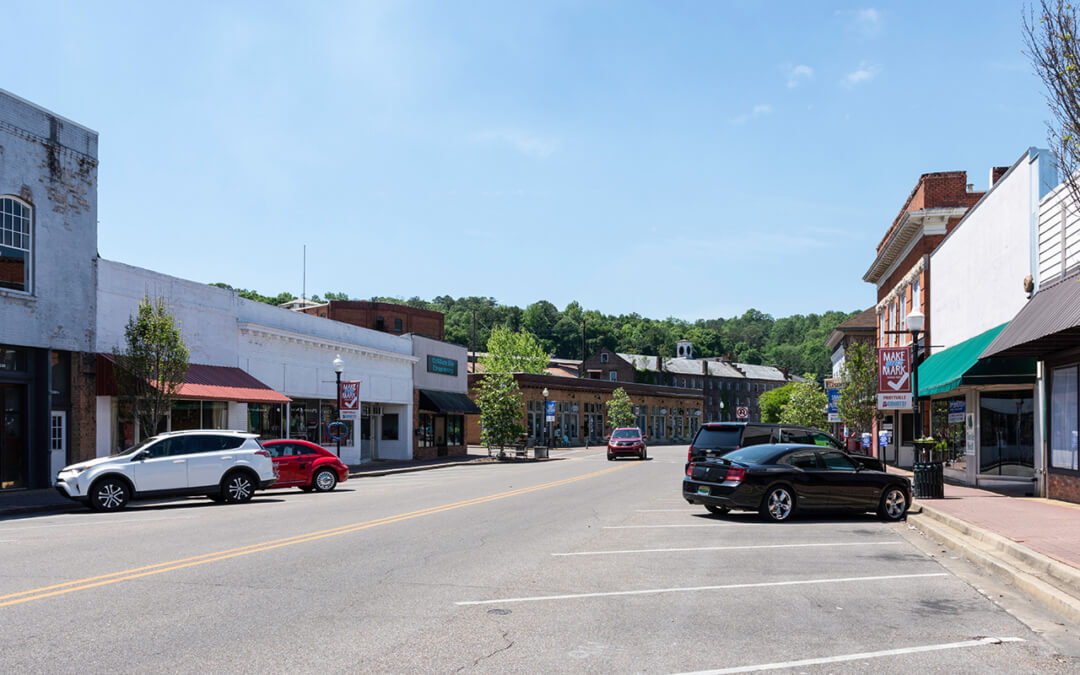
Overview
Prior to the current coronavirus recession, most U.S. economic metrics pointed to a slow but steady nationwide recovery amid an 11-year post-Great Recession run of economic growth. But prosperity was not spread equally across the breadth of the nation. In addition to widening income and wealth gaps, new data show that rural communities did not reap widespread benefits compared to urban regions of the country. The reasons for this gap between urban and rural economic growth bear serious policy consideration as the coronavirus pandemic sweeps across the nation.
During the 11-year recovery following the Great Recession of 2007–2009, Gross Domestic Product growth in rural America lagged behind urban GDP growth, according to the recently released Local Area GDP measure, which provides annual GDP growth data by county and industry. Rural areas in the aggregate experienced post-recession growth of 14.8 percent while urban areas registered 19.2 percent growth. When the data are broken down regionally, we see that the largest urban-rural divide is in the West, which consists of California, Oregon, Washington state, Alaska, and Hawaii. (See Figure 1.)
Figure 1
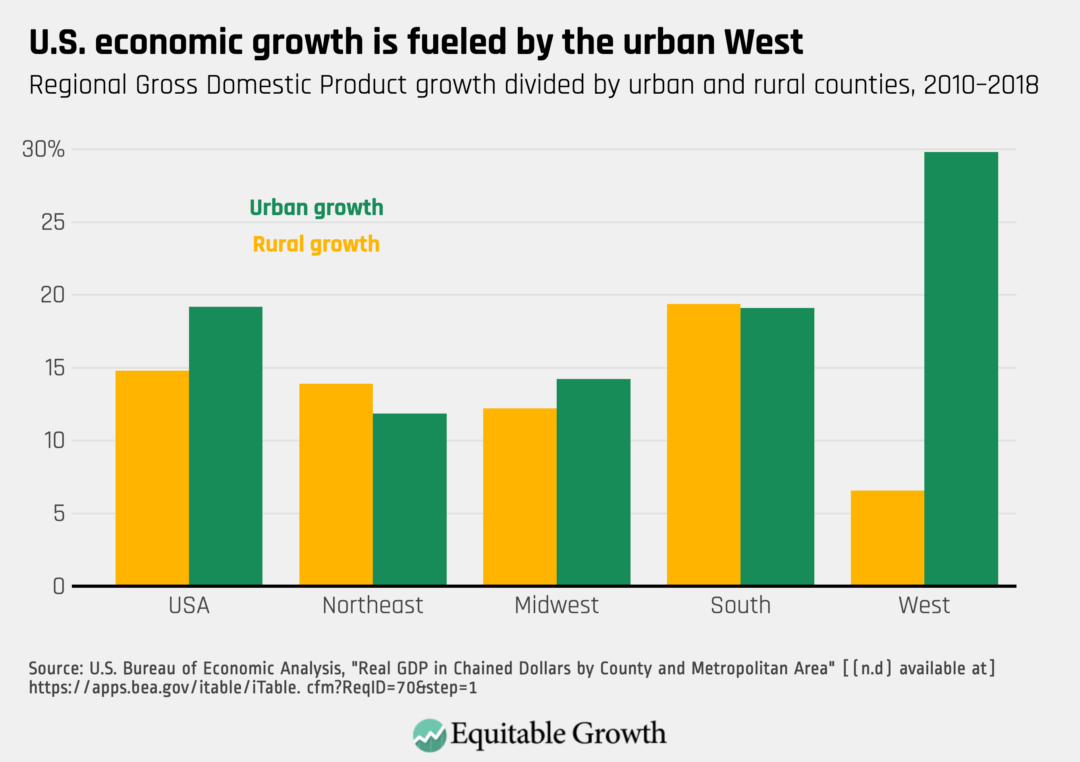
Demographic and industry breakdowns
This divide in urban and rural outcomes was driven by changes in demographic and industry composition. Rural and nonmetropolitan areas have a higher share of older people over 65 years of age, 17.5 percent, meaning labor force participation rates will drop as rural communities age. In addition to age, educational attainment contributes to declining labor participation and outcomes because half of prime-age adults (ages 25 to 54) held no more than a high school diploma in rural communities. Decreasing educational attainment brought about an ever-widening labor force participation gap between rural and urban areas.
Looking at the regional breakdown of urban and rural growth, it is evident that rural communities rely on specific industries for economic growth and sustainability. Rural counties in some states such as Texas and Oklahoma depended on the mining and fracking industries for long-term growth after the Great Recession. (See Figure 2.)
Figure 2
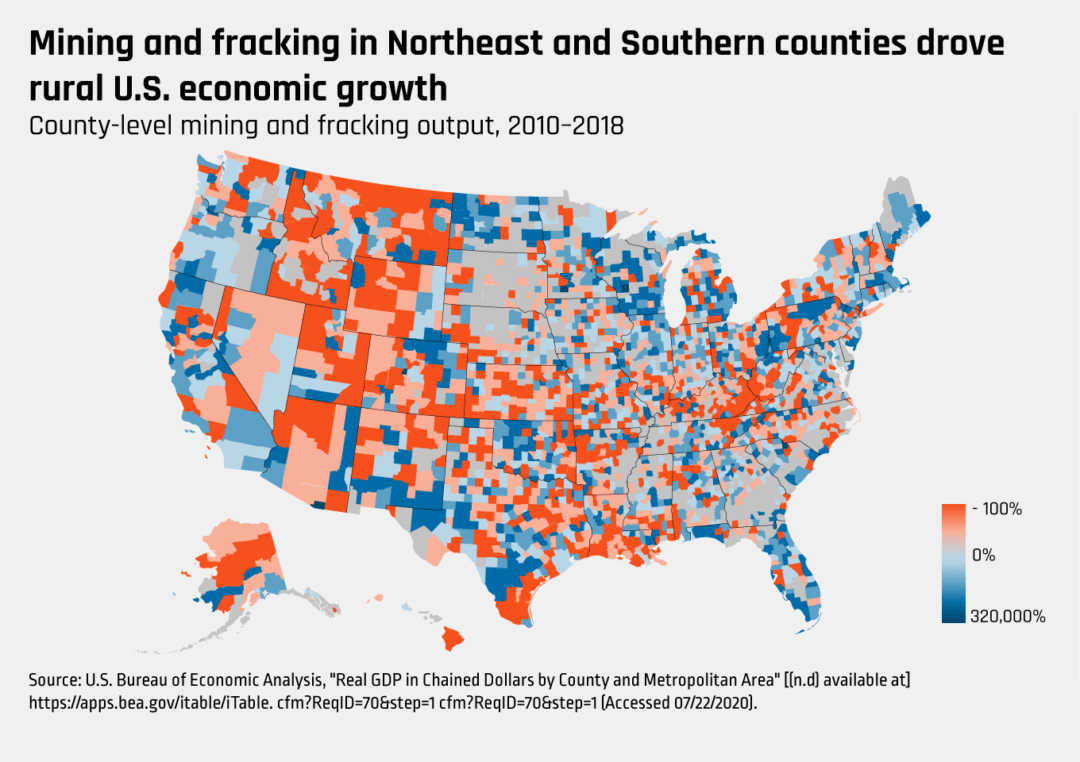
Indeed, Louisiana’s rural counties witnessed a 30 percent decline in post-recession output, yet the entire Southern region’s rural growth was able to counteract this decline partially through mining and fracking output in Texas. As a result, the South, as well as the Northeast, experienced large shares of growth coming out of the mining and fracking sector. (See Figure 3.)
Figure 3
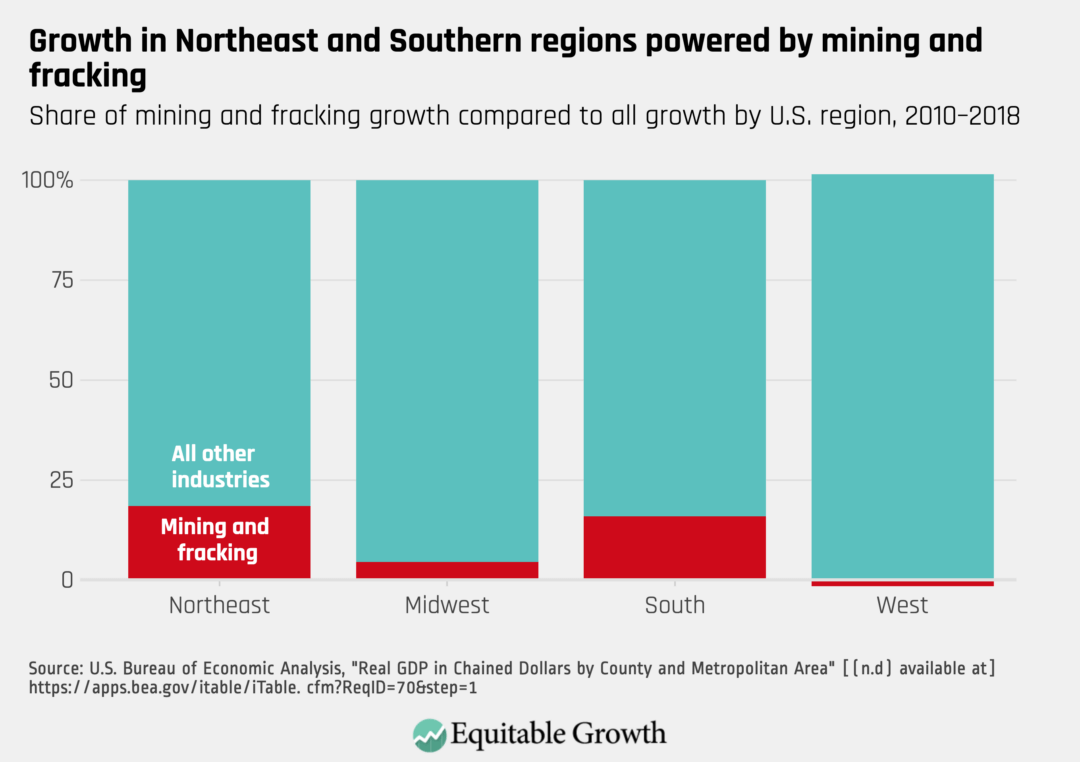
Beyond farming, mining, and fracking, the rural economy relied heavily on the service industry as a form of sustainable employment. In 2016, data from the U.S. Census Bureau’s American Community Survey showed that 22 percent of people living in completely rural counties (counties in which 100 percent of the population live in a rural area) were employed by the educational, healthcare, and social assistance service sector. Another 7.3 percent worked in the arts, food, and accommodations service sector. Yet even though many rural workers depended on services over fracking, mining, and agriculture, the service industry output fell short for these communities during the post-Great Recession run of economic growth.
What’s more, growth in the rural service sector lagged behind similar industries in urban communities. In the South and the West, there was a 14 percentage point and 16 percentage point gap, respectively, in the growth of service output between urban and rural communities. The gaps were smaller in the Midwest and especially in the Northeast. (See Figure 4.)
Figure 4
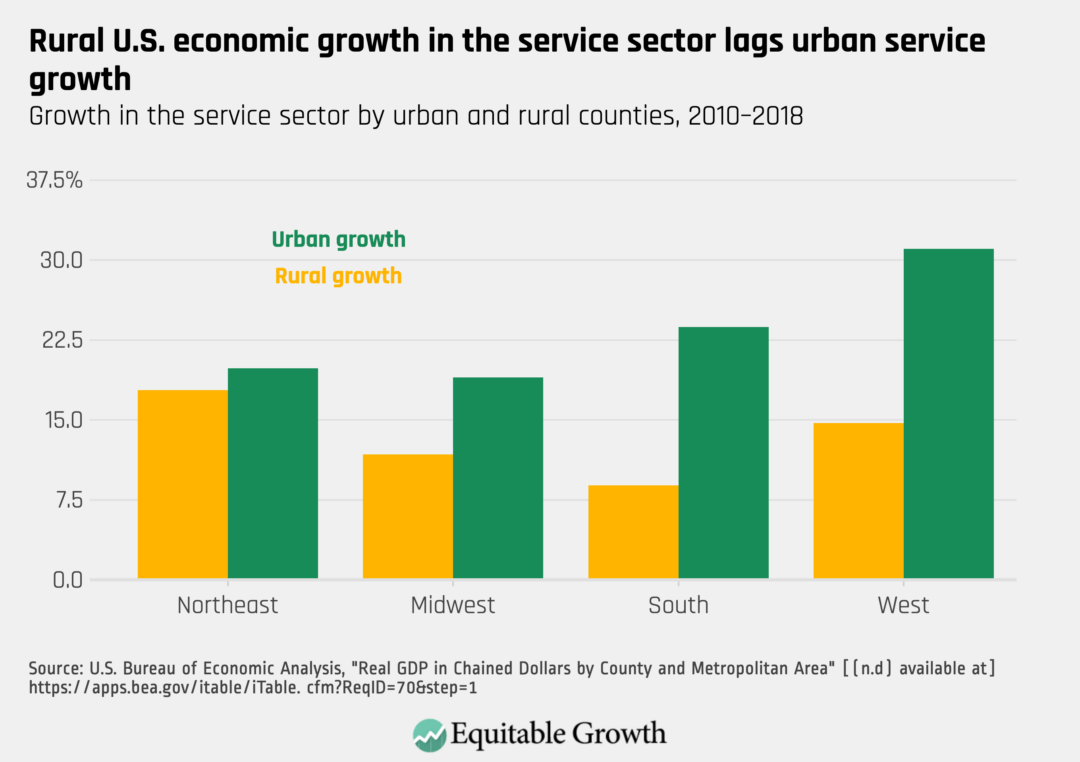
Rural and urban and regional economic growth gaps in healthcare
Then, there’s the healthcare sector. There are widespread regional and rural-urban divides in economic output in healthcare since the Great Recession. Rural counties in the West and Rocky Mountain states experienced growth in healthcare while rural counties in the South, Midwest, and Northeast registered more contraction in this industry since the previous recession. (See Figure 5.)
Figure 5

One explanation for such geographic divides is the growing trend of healthcare professionals moving away from rural counties toward urban counties, where hospitals are growing rather than closing or consolidating. Since 2010, 130 hospitals in rural communities have closed their doors, predominantly in the South. A study from the Chartis Center for Rural Health estimates that another 453 hospitals out of the remaining 1,800 are vulnerable to closure based on their performance and funding support between 2019 and 2020.
In addition to funding struggles and closures, rural hospitals are often vulnerable to mergers and acquisitions. Between 2007 and 2012, approximately 8 percent of rural hospitals, or 121, were involved in a merger. These hospitals had fewer profit margins, a lower percent of outpatient revenue coming from Medicare, a smaller ratio of full-time-equivalent, or FTE, employees to hospital beds, and higher amounts of debt compared to hospitals not involved in a merger. Researchers found that after the mergers, salaries went down by more than $1,220 per FTE employee, or almost $645,000. Other studies show that rural hospitals that merged with larger hospital systems experienced a decline in services provided, such as diagnostic imaging and outpatient care.
Despite the reduction in services, these rural hospitals showed significantly increased operating margins, which indicates that they aren’t performing at any greater efficiency than before the mergers took place.
The preservation and improvement of rural hospitals is crucial to the growth of the rural economy, particularly amid the current pandemic. Without accessible and good-quality healthcare, rural workers won’t be able to effectively work and promote growth within their local economies. Lack of accessible healthcare in rural counties means people risk losing their jobs in order to travel further distances to seek medical care that they can’t afford, thus exacerbating the social disparities in rural and urban public health outcomes.
Protecting healthcare accessibility doesn’t mean preserving poorly operating hospitals. In order to close the growth gap between rural and urban communities, policymakers should look at ways to strengthen healthcare accessibilities, such as providing public funding for nonprofit rural healthcare or expanding Medicaid in states with higher rural populations.
Reasons for the growth gap between rural and urban economies
Research by Charles S. Gascon and Brian Reinbold of the St. Louis Federal Reserve credits the urban-rural growth gap to agglomeration effects, which are seen when urban cities experience stronger growth because of firms’ access to resources that increase productivity, such as airports, efficient public transportation, and large pools of consumers. Some urban firms do provide services that spill over into rural communities, such as an urban hospital providing telemedicine to rural patients. But this is still output generated by and for urban areas, and so improvements in rural accessibility to resources primarily boosts urban output and growth. Nonetheless, these spillover effects and increased accessibility to cities’ resources improve rural prime-age adults’ employment prospects and optimism.
On the urban side, much of the gap is attributed to a technology boom concentrated in major metropolitan areas such as San Francisco, Boston, Austin, and New York. The rise of the tech industry worked in tandem with the phenomenon known as the rural brain drain. Young and talented individuals raised in rural communities are migrating to metropolitan areas in waves, searching for jobs in new industries and a higher quality of life.
In a study conducted by demographers Ken Johnson at the University of New Hampshire and Richelle Winkler at Michigan Technological University, the data show that large metropolitan areas experienced net population gains while nonmetropolitan areas experienced net population losses of people ages 20 to 34 years old. As a result of the decreased supply of workers, tech industries are failing to establish themselves in rural areas, despite the relatively low cost of living in such areas.
Policy implications
It is imperative that policymakers consider rural communities when discussing economic policy initiatives. Programs that promote urban growth, for example, may have negative effects on the rural economic expansion. Through the use of data, such as the U.S. Bureau of Economic Analysis’s Local Area GDP measure, academics and policymakers alike can track rural industry trends and create policies that promote a stable and resilient rural economy.






